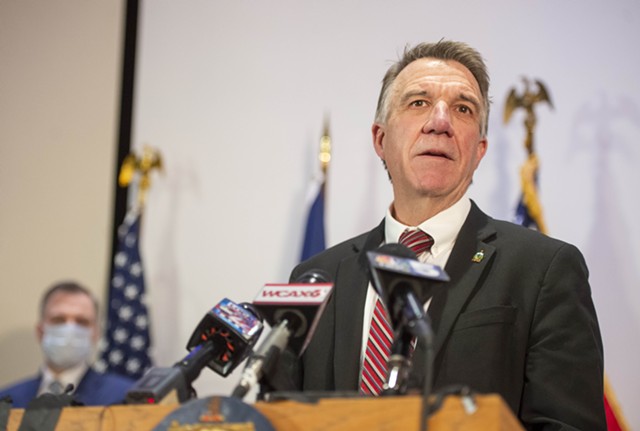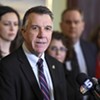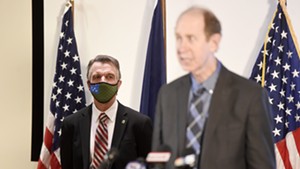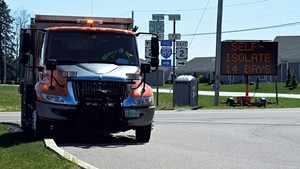
- File: Jeb Wallace-Brodeur
- Gov. Phil Scott
Gov. Phil Scott on Wednesday announced plans to accelerate the state's health surveillance efforts with a goal of slowing coronavirus outbreaks.
The new testing and contact tracing strategy should allow the state to better track and prevent the spread of the disease so that more Vermonters can get back to work, the governor said.
"If you think of this whole pandemic as a forest fire, testing will allow us to spot those embers early, and contact tracing allows us to surround it in order to contain it," Scott said at a press conference.
The new strategy was announced on a day when the Vermont Department of Health reported no new coronavirus cases for the first time since March 13.
The state continues to ramp up testing capacity, Health Commissioner Mark Levine said. Shortages during the "early days of the pandemic" regularly brought
the
state within 48 hours of running out of supplies, he said.
But thanks to "resourcefulness" and "creativity," the state has bolstered its supply chains and stockpiled resources in recent weeks, according to Levine, who praised health department employees for their "Herculean efforts."
As a result, Vermont will soon have the capacity to perform 1,000 tests per day, far more than it has averaged since the crisis began, Scott said. The state will also continue adding resources to its contact tracing team.
These efforts, Levine said, should allow the health department to better curb the spread of the virus by identifying and containing people before they start showing symptoms.
Officials warned that the new testing strategy will not happen overnight and said the state will need to continue stockpiling some resources to prepare for any outbreaks or second waves in the months ahead.
"By taking this approach, we can give our public health workers the room they need to make adjustments along the way," Scott said.
State officials didn't offer many specifics about how the new testing approach will impact the general population. But they did single out several high-risk groups, including health care professionals and those who live and work inside of long-term care facilities and prisons.
Earlier this month, the health department announced that it would provide building-wide testing for any long-term care facilities that report a single positive case.
On Wednesday, Levine said the department will also now routinely follow up with any of these facilities to perform four additional building-wide tests over a two-week period to prevent other outbreaks. Testing will occur at intake, discharge and for certain residents who require regular care outside of the facility, Levine said.
"These are the people who are most at risk of needing hospitalization [and] stretching our health care resources when we're trying to restart Vermont," Levine said. "It's critical for the health and safety of these populations that we act to limit the spread of illness as quickly as possible."
Levine said the state will also test every prison staffer over the next two weeks. And non-symptomatic health care professionals who may have come into contact with COVID-19 patients can now also be tested.
"Expanding testing to this central workforce will not only ensure that we keep our health care heroes healthy, safe and ready to respond as they are needed," the health commissioner said, "it will also be a critical tool in protecting Vermonters who count on these health care workers for their care."
Moving forward, the state will also "consider" testing anyone who is in 14-day quarantine from a potential exposure and will increase testing opportunities for childcare workers, whom "so many rely on" to stay in the workforce, Levine said.
New contact tracing strategies will be key as increased testing will likely result in more positive cases, state epidemiologist Patsy Kelso told reporters at the press conference.
Kelso expects that new cases will require more legwork than recent ones, since patients likely will be coming into contact with more people as Vermonters return to work.
The state has 53 people now working on contact tracing and can add up to 50 more if needed, Kelso said. The health department is also prepared to trace anywhere from 300 to 900 new cases a week using technology that allows the state to routinely check in and monitor positive patients. And tracers have started asking patients about where they went before showing symptoms, which may help identify where they were infected.
Kelso said these efforts will "help us ensure we're on top of every case."
Scott, who has
loosened business restrictions each of the last two Fridays, said he would have more to say about restarting the economy at the end of the week.
But while he said it was "great news" that Vermont had no new cases to report on Wednesday, he warned that a single day does not make a trend and said that more cases are likely as more businesses reopen.
No matter how many tests the state performs, Scott said, "it won't completely eliminate the risk." He said that's why the new strategy will only help the state's attempt to restart the economy if Vermonters continue to follow proper health guidance.
"It's really up to each and every one of us to make this work," he said.


















Comments
Comments are closed.
From 2014-2020, Seven Days allowed readers to comment on all stories posted on our website. While we've appreciated the suggestions and insights, right now Seven Days is prioritizing our core mission — producing high-quality, responsible local journalism — over moderating online debates between readers.
To criticize, correct or praise our reporting, please send us a letter to the editor or send us a tip. We’ll check it out and report the results.
Online comments may return when we have better tech tools for managing them. Thanks for reading.